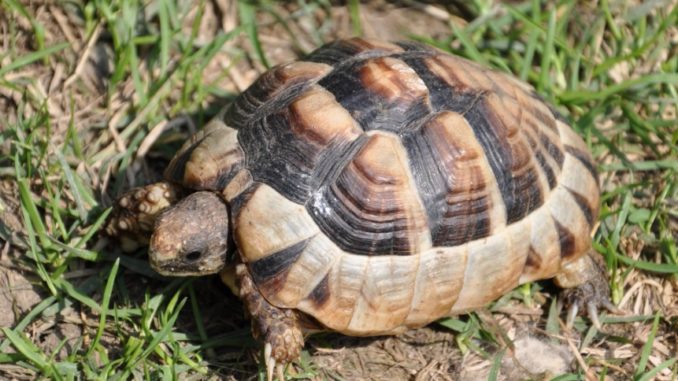
The marginated tortoise traces its origins back to the Balkans in Southern Europe and Greece in Italy. Together with four other tortoise species, they are popularly referred to as the Mediterranean tortoises and are recommended for beginner or amateur pet enthusiasts. Of the known European tortoises, it is by far the largest by size. If properly cared for, the turtle can live for up to a century.
Enclosure
A marginated turtle can have a length of up to fourteen inches and can weigh as much as 11 pounds. Apart from making for enjoyable pets, they are also hardy animals, which means that they also require proper housing. The best way to house this type of pet is indoors. You can use a tortoise table for this purpose or any other open enclosure that you may chance upon.
Ensure that each tortoise has access to at least four square feet. But if possible, try to get it as much space as possible. For those looking to house many tortoises, e.g., a female and a male, make sure that you have enough room in the enclosure. Their housing should also offer them some unique sight breaks. Common sight breaks include top-soils and play sand.
When it comes to outdoor housing, look for an area that is secure. This is important especially for a person who has juvenile tortoises. Security helps prevent escape, theft, and predation. The location you settle for has to be large enough for it. The best habitat ought to provide your tortoise with lawn, soil, and a broad array of plants.
Consider housing it in a wooden shelter that features a rainproof lid. The lid will provide an environment that is dark and cool and will protect it from too much light. Take a closer look at the outdoor housing unit to confirm that it is, in fact, escape-proof. Marginated tortoises are known to dig and climb over some of their outdoor housing units.
It is not recommended to house it on a run on a lawn. The reason is that the grass may be too damp for it, which may, in turn, lead to the development of health problems.
Temperature
These particular tortoise species require a basking spot that has reasonable heat temperatures. It means that the temperature should be high, but not too high. Check to confirm that the coolest part of the enclosure has a minimum temperature of 22 C. On the other end, confirm that the warm end has a temperature of at least 30 C.
For the warmer end, try to make certain that the heat is provided by a combined bulb (mercury vapor lamp) or a spot bulb. Traditionally, you can always choose to leave your tortoise outside without any form of heating between the months of May and September. It is, however, not uncommon to find many pet owners providing their tortoises with additional heating after housing them outdoors. Alternatively, you could also opt to bring them inside the house when there are bad weather conditions or at night.
Lighting
Lighting is one of the requirements to keep in mind when dealing with marginated tortoises. If you intend to keep your tortoises indoors, then ensure that they have a full spectrum light. The light ought to produce UVa and UVB light. You can opt to use a combination of mercury vapor bulb or strip light.
The mercury vapor bulb is the best as it also gets to provide your pet with a basking light. If using UV strip lights, ensure that you get to replace them at the end or beginning of every new season. If you house them outside, you will not need additional lighting as they will get all the light they require directly from the sun.
Humidity
This particular species does very well in areas with low or moderate humidity. Regions or areas with higher humidity can cause the pets to develop respiratory issues. You can always provide your pets with a moist substrate that they can use to burrow. This helps them regulate their temperatures and humidity conditions.
Feeding
A tortoise, like any other pet, will need to feed on a regular basis. However, note that the tortoise is an herbivorous animal. Its diet should, therefore, reflect this lifestyle. Some of the plants to include in its diet will include hostas, dandelions, clover, geraniums, sow thistle, pansies, vetch, plantains, and bindweed.
Ensure that you feed it daily, and the feeds are enough to cover its entire shell. Before feeding them, ensure you dust the weeds for calcium.
Hibernation
When in the wild, a marginated tortoise is known to hibernate naturally during the cold winter months. It is, therefore, recommended to make sure that your tortoise hibernates every year for a period of 3-4 months. Their hibernation temperature should be between 4 C and 8 C.
As seen above, the marginated tortoises require special living conditions, diet, lighting, and temperature conditions for them to thrive. If unsure of anything, make sure to seek expert advice from local tortoise and pet store owners. A healthy marginated tortoise should have clear, bright eyes, and a firm shell. It should also be active.

Leave a Reply